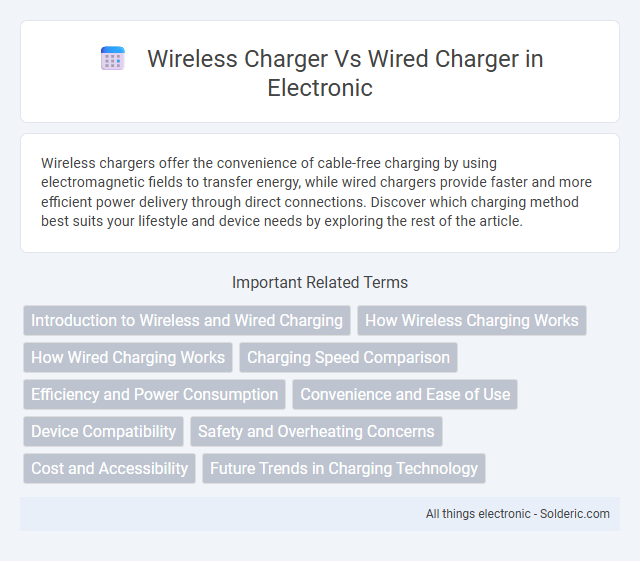Wireless chargers offer the convenience of cable-free charging by using electromagnetic fields to transfer energy, while wired chargers provide faster and more efficient power delivery through direct connections. Discover which charging method best suits your lifestyle and device needs by exploring the rest of the article.
Comparison Table
| Feature | Wireless Charger | Wired Charger |
|---|---|---|
| Charging Method | Inductive charging using electromagnetic fields | Direct cable connection via USB or proprietary cable |
| Charging Speed | Typically slower, ranges 5W to 15W | Faster, ranges 10W to 120W depending on charger and device |
| Convenience | Easy placement, no cables needed | Requires plugging and unplugging cables |
| Portability | Less portable, requires flat surface and power source | Highly portable, cable and charger can be easily carried |
| Device Compatibility | Limited to devices with Qi wireless charging support | Compatible with most devices with appropriate cable |
| Heat Generation | More heat during charging, can affect battery life | Less heat, more efficient energy transfer |
| Durability | Minimal wear on charging port | Port wear over time due to repeated plugging |
| Cost | Usually more expensive upfront | Generally cheaper and widely available |
Introduction to Wireless and Wired Charging
Wireless chargers use electromagnetic fields to transfer energy between a charging pad and a device, enabling cable-free power delivery through induction or resonance technology. Wired chargers rely on a physical USB or proprietary cable connection to deliver electrical current directly from the power source to the device, facilitating faster and more efficient energy transfer. Both charging methods have unique advantages, with wireless charging offering convenience and reduction of cable wear, while wired charging typically provides higher power throughput and faster charging times.
How Wireless Charging Works
Wireless chargers use electromagnetic fields to transfer energy between a charging base and a compatible device through inductive coupling. A coil in the charger generates an alternating electromagnetic field, which induces a current in the receiver coil inside the device, converting it into electrical energy to charge the battery. This technology allows for cable-free charging but typically offers slower power transfer and reduced efficiency compared to wired charging solutions.
How Wired Charging Works
Wired charging transfers electrical energy directly from a power source to your device through a physical cable, ensuring faster and more efficient power delivery. The cable connects to your device's charging port, allowing consistent voltage and current flow that supports rapid battery replenishment. This direct connection minimizes energy loss compared to wireless methods, making wired charging ideal for quickly restoring battery life.
Charging Speed Comparison
Wireless chargers typically offer slower charging speeds compared to wired chargers, with wireless models averaging around 7.5 to 15 watts, while wired chargers can deliver power ranging from 18 watts up to 120 watts or more depending on the charger and device capability. Fast-charging protocols like USB Power Delivery (PD) or Qualcomm Quick Charge enable wired chargers to replenish battery levels significantly faster, often charging devices to 50% in under 30 minutes. Wireless charging speed can also be affected by factors such as distance from the charging pad and device compatibility, resulting in longer charging times overall.
Efficiency and Power Consumption
Wireless chargers generally exhibit lower efficiency rates, typically around 60-80%, compared to wired chargers that often exceed 90% efficiency, leading to higher power consumption during wireless charging sessions. Your device may take longer to charge wirelessly while consuming more energy due to heat loss and electromagnetic interference inherent in wireless technology. Choosing a wired charger can significantly reduce energy waste and improve overall charging speed for better power management.
Convenience and Ease of Use
Wireless chargers provide enhanced convenience by eliminating the need for cables, allowing users to simply place their device on a charging pad for immediate power. Wired chargers deliver faster, more reliable charging speeds but require plugging and unplugging, which can be less user-friendly in daily routines. The choice between wireless and wired charging depends on prioritizing hassle-free usage versus optimal charging performance.
Device Compatibility
Wireless chargers support a wide range of devices equipped with Qi-standard technology, including most modern smartphones, smartwatches, and earbuds. Wired chargers offer broader compatibility, accommodating various devices with different charging ports like USB-C, Lightning, and Micro-USB. Choosing between wireless and wired chargers depends on the device's interface and the convenience required for daily use.
Safety and Overheating Concerns
Wireless chargers incorporate advanced safety features such as temperature regulation and foreign object detection to prevent overheating and potential hazards. Wired chargers, while generally faster, can pose risks if cables or adapters are damaged, leading to electrical shorts or excessive heat. Both methods benefit from certified quality standards like UL or CE to ensure safe and reliable charging performance.
Cost and Accessibility
Wireless chargers typically cost 20-50% more than wired chargers due to advanced technology and convenience features, making wired chargers more accessible for budget-conscious consumers. Wired chargers are widely available across various retailers and compatible with most devices, ensuring easier accessibility compared to wireless options that require specific receiver compatibility. Cost-efficiency and universal compatibility make wired chargers the preferred choice for users prioritizing affordability and widespread availability.
Future Trends in Charging Technology
Wireless chargers are evolving with advancements in higher power transfer, faster charging speeds, and enhanced compatibility across multiple devices, driven by Qi wireless charging standards. Innovations such as magnetic alignment and integration with IoT ecosystems are shaping the convenience and efficiency of future charging solutions. Wired chargers, while maintaining their advantage in fast-charging performance, are expected to become more compact and incorporate USB-C Power Delivery technology to support universal device compatibility and higher wattage outputs.
wireless charger vs wired charger Infographic

 solderic.com
solderic.com